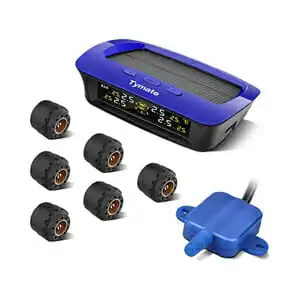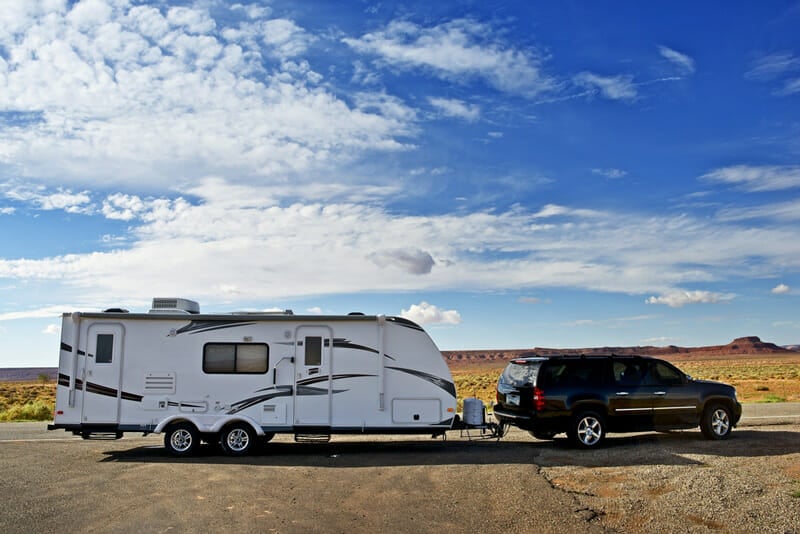Tire Pressure Monitoring Systems For RV Campers (TPMS)
A Tire Pressure Monitoring System (TPMS) can reduce the chances of a blow-out on the highway. This can save you money on a new set of tires, prevent you from getting stranded, and help you avoid accidents.
In cars and regular vehicles, TPMS have been mandated to be factory installed since 2007. Motorhomes don’t have this requirement so many do not come with a TPMS installed. Everyone should have a TPMS. Not only are they safer for you, but they are safer for everyone driving around you.
- Flow-thru sensors
- Color monitor
- Auto-scrolling monitor
- Customize each axle for high and low alert parameters
- Cap sensors
- Compatible with iPhone, iPad, and Android devices
- Monitors up to 22 tires
- Auto-scroll, auto-search, two-part disconnect & advanced functions
- Cap sensors
- Solar power & USB charging
- 6 external sensors
- Displays pressure and temperature simultaneously
What Does A Tire Pressure Monitoring System Do?
The best tire pressure monitoring systems will measure tire pressure and tire temperature. Blowouts happen most often when a tire has low pressure for a continuous amount of time. This is because tire sidewalls flex and heat up at highway speeds, causing the rubber to weaken and crack.
Put simply: Under-inflation causes excess heat, and high heat causes tire failure.
A TPMS will set off a warning signal when high heat or low pressure is detected. This gives you time to pull over and either cool off or reinflate your tires before they blow out.
Tire pressure monitoring systems are significantly less expensive than a new set of tires so they’re worth the investment. They can also improve your gas mileage because your tires will always be properly inflated.
Monitoring systems are especially important if you’re towing a 5th wheel or travel trailer. That’s because you may not be aware that a tire has blown out which will lead to even more damage and expensive repairs.

How Does It Work?
TPMS sensors are placed either on the valve stem or inside each of your wheels. The sensors monitor pressure on the tire and air temperature around the tire. It then broadcasts a radio signal to the monitor in your RV. Most systems use a 12v signal repeater to boost the info to your monitor.
The monitor will inform you with an audio alert or visual display when the system determines the tires are getting too hot, or the pressure is getting too low.
Monitors are programmable, so you can input the pressure required for your load. The best monitors can display stats on each tire individually including:
- Low-pressure alert
- Tire temperature
- Slow leak detection
- High-pressure alert
Types Of Tire Pressure Monitoring Systems:
There are three types of tire pressure monitoring systems: cap sensors, flow-thru sensors, and internal sensors. Choosing the best one for your RV depends on your budget and the type of tires you own.
Cap Sensors
Cap sensors are the least expensive. They are placed directly on the valve stem and need to be taken off when filling the tires with air. These are lightweight and have a low power draw. Cap sensors work with all valve stem types and come with user-replaceable or sealed batteries.
Flow-thru Sensors
Flow-thru sensors are the most convenient. They are placed on the valve stem and allow you to inflate tires without taking the sensor off. These sensors come with replaceable batteries so you can keep using the sensors for many years.
Flow-thru sensors are slightly longer than cap sensors and can wear down plastic stems over time because of the length. For that reason, it’s recommended that you only use flow-thru sensors on tires with metal valves.
Internal Sensors
Internal sensors are the least popular and most expensive because you have to break down each tire to install them. These sensors are placed inside the wheel and can last about 5 years before they need to be replaced. This is also the most robust system and is what is installed on standard vehicles from the factory.
How Much To Inflate Your Tires
All tires come with an inflation chart which will tell you the exact pressure you should use for your load. Of course, in order to properly inflate your tires, you need to know how much your RV weighs.
Do this by taking your camper to a certified weigh station that can assess individual wheel weights and help you identify tire loading issues. Once you know the weight of your vehicle, refer to the chart that came with your tires to properly inflate them and program the TPMS.
Your recommended tire pressure should be its cold tire inflation pressure. That means you should inflate your tires prior to starting your trip or within the first few miles of driving. Even things like sun on the tires can heat them up (usually unevenly as some of the tires will be in the shade).
What To Look For In A Tire Pressure Monitoring System
Tire pressure monitoring systems vary widely from the most basic monochromatic monitors to auto-scrolling systems that have anti-theft devices and slow leak detection. Before purchasing a TPMS you should be aware of the different options available.
Monitor Mounts: TPMS monitors come with either a dash pad or a suction cup mount that attaches to your windshield. The layout of your cab may make a difference in your purchasing decision.
Monochromatic vs color: Most TPMS devices are monochromatic (black and white). That’s because these systems have a lower power draw and colored indicators aren’t that necessary. However, colored monitors are easier to read at a quick glance which means you can keep your eyes on the road longer when driving.
Auto scrolling vs manual scrolling: Some TPMS devices will automatically scroll through the stats on each tire every few seconds. Other monitors require you to navigate through the screen using buttons. The best one depends on your personal preference. If you frequently travel with a partner, that companion might have an easier time manually scrolling and checking the stats periodically.
Data points: The best TPMS can measure both high and low pressure, temperature, slow leak detection, sensor fault alarm, and sensor battery low power alarm.
Repeater: Any reputable TPMS device will have a 12v repeater signal so you can get an accurate reading even when driving through rough conditions.
Activation Type: Tire pressure monitoring systems are activated either by motion or by pressure. Pressure activated systems give you data immediately when they are turned on. Motion-activated systems only display data while you’re driving which can save a little bit of battery life during your travels.
Replaceable batteries vs sealed: User-replaceable batteries typically last about 1 year. Sealed batteries can last up to 5 years, but they require you to replace your whole sensor. Replaceable batteries are preferred unless you are purchasing inexpensive cap sensors.
Number of sensors: You should purchase a TPMS that can support the number of tires on your vehicle; one sensor for each tire. Some systems like the TireMinder can monitor up to 22 tires at a time.
Anti-theft devices: Locking nuts and spinning caps are the most common anti-theft devices that you’ll find on a TPMS.
How To Install A Tire Pressure Monitoring System
Frequently Asked Questions
- Can you use TPMS with nitrogen-filled tires? Yes.
- Can you use a valve extension with a TPMS? Yes, but you should not use them with the flexible, braided valve extenders. You should only use them with quality extenders.
- Will they interfere with factory-installed sensors? No.
- Will sensors affect the balance of your tires? No, they are too light to make a difference.
The Best TPMS Brands
The most popular tire pressure monitoring system brands are TST Truck System Technologies, TireMinder, InnotechRV, Pressure Pro, EEZTire, and Tire Tracker.
When To Check Your Tire Pressure
You should check your tire pressure before starting any road trip. Always do this with cold tires, or within the first few miles of driving. With a TPMS, all you have to do is turn on the monitor. If you don’t have a TPMS, you should check with an accurate tire pressure gage.
Infrared thermal guns are also a useful tool to have on the road because you can point it at each tire during a rest stop and make note of any wheels that look unusually warm compared to the others.
Continue Reading:
- RV leveling blocks and risers
- Wheel chocks and stabilizers
- Best roof sealants for leaks and cracks
- RV GPS units







I installed a Truck Systems Technology kit on my 35′ bus conversion. It was easy and works flawlessly. I did not install the included repeater, figuring that I’d try it without. Recently, I carried the display unit into my home to charge it up. While it is charging, it apparently turns itself on. The unit was roughly 50 to 60 feet away from the bus at this time, but it still connected to all of the sensors and displayed the tire pressures inside of my brick house. That is a good solid signal, in my opinion. I cannot speak towards longevity, but so far, so good after a few months and a few thousand miles.
Truck Systems Technology product does an excellent job providing trailer tire pressure and temperature monitoring for our dual axle trailer RV. We ordered the six sensor kit to allow one monitor for the spare tire and one for a backup sensor if one ever gets lost or broken. Instructions were easy to follow, had it set up and working in 25 minutes. Our setup with a pickup truck towing a 25-foot travel trailer did not even require the included booster to function flawlessly. Can already tell our travels have less worry, being able to recognize tire issues before any real problem occurs.